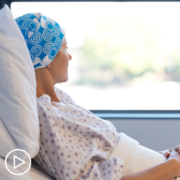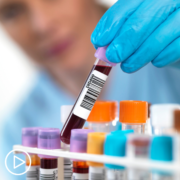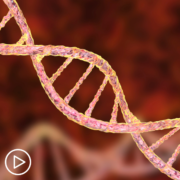Extended Quick Guide to Medicare
This guide was originally published by our partner, Triage Cancer, here.
2021-Health-Insurance-Medicare-Quick-Guide
This guide was originally published by our partner, Triage Cancer, here.
2021-Health-Insurance-Medicare-Quick-GuideThis guide was originally published by our partner, Triage Cancer, here.
2021-Health-Insurance-Options-Quick-GuideHow Can You Advocate for the Best Breast Cancer Care? from Patient Empowerment Network on Vimeo.
Breast cancer expert Dr. Julie Gralow explains how you can advocate for the best metastatic breast cancer care, through speaking up, utilizing care team members and taking key steps to achieving better care.
Dr. Julie Gralow is the Jill Bennett Endowed Professor of Breast Medical Oncology at the University of Washington, Fred Hutchinson Cancer Research Center, and the Seattle Cancer Care Alliance. More about this expert here.
See More From INSIST! Metastatic Breast Cancer
Katherine:
For patients who may be hesitant to speak out for themselves and advocate for their own care and treatment, what advice do you have?
Dr. Gralow:
You have a whole team who’s behind you, and I’m the MD on the team, but I’ve got a nurse practitioner, and a nurse, and a scheduler, and a social worker, and a nutritionist, and a physical therapy team, and financial counselors. I’ve got a whole team who works with me. And so, a patient might be hesitant to speak up during the actual appointment with their physician. It’s a short amount of time. I would recommend come into it with written-down questions because things go fast. You don’t get a lot of time with your doctor.
Things go fast, but don’t come in with 25 questions, either. Pick your top few that you want to get taken care of this visit because if you come in with 25 or 30, you’re going to lose the answers to most of them. Maybe bring somebody with you who’s an advocate and a listener for you who could be taking notes, so you can process and you don’t have to write it down, or ask if you can record it. It’s really important if you’re newly diagnosed or maybe there’s a progression and you’re going on a new treatment. That’s okay too.
But, I would also say you have a whole team behind you, so sometimes, if you don’t have time or if you’re hesitant to speak up in your doctor’s visit, you can ask the nurse, or maybe you can ask the social worker for help, even. See if there’s support groups around.
Interestingly, we’ve got a peer-to-peer network where patients can request to talk to somebody else who’s matched to them by some tumor features, and their stage, and things like that. Maybe finding somebody else who’s gone through something similar, and somebody independent to talk to instead of relying on your family.
It can also be really helpful to talk to a therapist or a psychologist about your fears, and sometimes, you want to be strong for your family, strong for your children and all, but you need a safe space with somebody that you can just express your fears and your anger if that’s what’s going on, or your depression or anxiety to while you’re trying to hold a strong face for others in your family. So, I would encourage patients to look at who is the whole team and talk to the other members of the team as well, and sometimes, they can help advocate.
Also, find somebody who might be able to come to your appointments with you, somebody who will help you advocate or remind you – “Didn’t you want to ask this question?” – or be another set of ears that you can process it with afterwards.
Katherine:
Dr. Gralow, we’ve covered a lot of useful information today for patients. Thank you so much for joining us.
Dr. Gralow:
Thank you, Katherine.
Katherine:
And, thank you to all of our partners. To learn more about breast cancer and to access tools to help you become a proactive patient, visit powerfulpatients.org. I’m Katherine Banwell.
What are some of the barriers to clinical trial participation? What is a virtual clinical trial? Should my doctor be speaking to me about my clinical trial options? Dana Dornsife, founder of Lazarex Cancer Foundation, speaks to the key barriers in trials and how COVID-19 has really opened the door for a lot of opportunity to engage with patients around clinical trials.
Barriers to Clinical Trial Participation from Patient Empowerment Network on Vimeo.
What is a Virtual Clinical Trial? from Patient Empowerment Network on Vimeo.
COVID and Clinical Trials: Has There Been a Shift? from Patient Empowerment Network on Vimeo.
How Can Breast Cancer Genetic Testing Empower Women? from Patient Empowerment Network on Vimeo.
Dr. Stephanie Valente explains how breast cancer genetic testing results can help women learn about their breast cancer risk and guide prognosis and treatment choices.
Dr. Stephanie Valente is the Director of the Breast Surgery Fellowship Program at Cleveland Clinic. More about this expert here.
See More From INSIST! Metastatic Breast Cancer
Dr. Valente:
So, genetic testing in this day and age is really empowering to a lot of women. So, it allows women to take control of their health from the beginning. So, if somebody has a strong family history of breast cancer, and that woman doesn’t have breast cancer but wants to know if she’s at an increased genetic risk for developing breast cancer in her lifetime – Knowing that risk and if a gene is identified, that woman could undergo high-risk screening.
So, saying if she develops breast cancer, it would be caught early, and she can go into a high-risk program. Or she can elect to prophylactically – meaning before cancer – remove her breasts. That would be both of the breasts with a mastectomy – Again, with or without reconstruction. And so, that decreases the risk.
Nothing in life is 100%. But it essentially decreases the risk of getting breast cancer. Some of the genes, like the BRCA gene – that’s a very common gene – is a 60% to 80% lifetime risk of developing breast cancer. And so, that would take that lifetime risk down to about 5% risk of developing breast cancer. And so, that’s empowering for a lot of women. And so, some women do elect to have that procedure.
The other thing for genetic testing is that for women who are diagnosed with breast cancer, sometimes the triple-negative breast cancer – finding out whether or not they carry a BRCA gene. We know that certain genes in triple-negative breast cancer allow patients to have better treatment outcomes with certain chemotherapy. So, the medical oncologist may opt to add a specific chemotherapy based on whether or not that patient actually carries a genetic mutation.
What Should You Know About the Role of Surgery in Breast Cancer Treatment? from Patient Empowerment Network on Vimeo.
Dr. Stephanie Valente explains how surgery approaches, including mastectomy and lumpectomy, are used in treating breast cancer, and addresses common misconceptions about mastectomy.
Dr. Stephanie Valente is the Director of the Breast Surgery Fellowship Program at Cleveland Clinic. More about this expert here.
See More From The Pro-Active Breast Cancer Patient Toolkit

Metastatic Breast Cancer: Accessing the Best Treatment for YOU |

When Is a Full Mastectomy Appropriate for Breast Cancer Patients? |

|
Dr. Valente:
So, breast cancer patients have the option to remove their whole breast, which is called a mastectomy. And if they pick that option, they could choose to have reconstruction or to essentially go flat. Yes, we have even done reconstruction in metastatic breast cancer patients. Metastatic breast cancer patients live for a really long time, so giving them reconstruction to make them feel whole and kind of put them back together after a mastectomy is definitely a good option.
The other option is to just remove the cancer. So, if the patient has a small breast cancer, and it’s metastatic, we can just say – Hey, you don’t have to have the whole breast removed. So, we can do a lumpectomy, as well.
So, a lumpectomy is essentially a surgery that removes the cancer with a normal rim of tissue around it. We also call it a partial mastectomy, meaning you’re removing just part of the breast. Or it’s also called breast-conserving surgery. So, it’s any method that removes that cancer with a normal rim of healthy tissue around it but allows the woman to keep her breasts.
So, when it comes to surgical choices and a cancer coming back, some women think that if they pick the most advanced surgery, such as a mastectomy, it helps prevent cancer from going somewhere else in the body. And that’s actually not true. Removing both breasts, doesn’t make you live one day longer. At that point, a mastectomy or a lumpectomy is a choice.
And prognosis – meaning whether or not the cancer’s gonna show up somewhere in the body – is based really on two things – the stage at which the breast cancer presents itself and what type of breast cancer it is – meaning is the cancer outside of the lymph nodes? How large is it? And if it’s a triple negative or some other type of breast cancer? Those determine the higher likelihood that somebody could develop metastatic breast cancer later in their life, even though small, early-stage breast cancers, unfortunately, can also develop metastasis later on in life.
But women sometimes think that if they pick the most aggressive surgery, it’s helping prevent metastatic spread later on in life. And that’s actually not the choice. Breast cancer surgery is the option that women choose to surgically remove their breast cancer. But again, choosing a mastectomy or a lumpectomy for an early-stage breast cancer is a choice of how they wanna remove the breast cancer. But it doesn’t improve the chances that they won’t have metastatic spread later on.
So, the role of surgery for metastatic breast cancer is mainly for what we call to remove the cancer or sometimes for local control. So, the number one treatment if somebody is diagnosed with metastatic breast cancer is systemic therapy. That might be chemotherapy or endocrine therapy. But it’s really to get the metastatic disease under control.
So, where does breast cancer usually go? Bones, liver, lungs, brain. So, surgery to remove the breast or the breast cancer in the breast doesn’t really take care of those problems. But a lot of times for metastatic cancer, the one reason would be for local control. So, if the cancer is causing issues in the breast – swelling, coming out of the skin – where it’s a wound issue, then we’ll remove that to get better control of the area in the breast.
The other reason is if somebody has metastatic cancer, and their cancer in the other area of their body is controlled with the therapy, then we say – Hey, chemo’s working, or the systemic therapy’s working. The only thing that seems to be left is the area in your breast. Then for a conversation with medical oncology, we say you don’t have to come off your medications. This is a good time to remove the breast cancer to control that problem.
Metastatic Breast Cancer Treatment and Research News from Patient Empowerment Network on Vimeo.
As metastatic breast cancer testing approaches continue to expand, new and promising treatments have emerged. Dr. Lisa Flaum shares information on recently approved treatment options and the role of genetic markers in accessing targeted therapy.
Dr. Lisa Flaum is a Medical Oncologist at the Robert H. Lurie Comprehensive Cancer Center of Northwestern University. Learn more here.
See More From The Pro-Active Breast Cancer Patient Toolkit

|

Essential Testing Following a Metastatic Breast Cancer Diagnosis |

Metastatic Breast Cancer Treatment Decisions: Which Path is Best for You? |
Dr. Flaum:
There are a lot of new and promising treatments for metastatic breast cancer. So, the treatments in general and the novel treatments and studies really vary based on the subset of metastatic breast cancer. So, when we’re making our treatment decisions, a lot of it is defined by those markers. So, if someone has a tumor that is hormone receptor, estrogen and progesterone receptor positive, and HER2-negative, the mainstay of treatment is typically drugs that target estrogen and often partnering drugs that target estrogen with other more novel or newer treatments.
So, just in the last five plus years, there have been a number of new drugs and even new drug categories that we didn’t have previously. So, for that population of the estrogen receptor positive tumors, the biggest breakthrough over the last number of years has been a class of drugs called CDK4/6 inhibitors. So, that includes drugs like Ibrance, Kisqali, Verzenio. And they’ve emerged as a very important and effective and often a recommendation for our first-line treatment for these patients combined with anti-estrogen therapies that have vastly improved outcomes for patients. So, a much higher percentage of patients respond to these drugs, the duration of the responses has extended quite a bit. And importantly, patients tend to tolerate this drug class really, really well.
So, for many patients starting out with that diagnosis, this type of drug class is going to be part of the discussion. Even in the last year, another drug category has emerged with approval of a new drug called alpelisib, which is something called at PI3 kinase inhibitor. So, again, back to defining the options based on the molecular profile of the tumor. So, this newer oral drug also partnered with anti-estrogen therapy, has been an important breakthrough for the treatment of patients who harbor this specific molecular abnormality. So, important to define whether that’s an option by some of these molecular testing.
There’s also newer drugs and studies of newer drugs that affect the estrogen receptor in different ways than some of our traditional medications.
And this is an ongoing area of significant research. So, that’s the estrogen receptor positive tumors.
For patients who have HER2-positive tumors, these are tumors that tend to be more aggressive, that tend to require more aggressive upfront treatment, which usually involves drugs that specifically target HER2. So, again, defining what’s driving the tumor and hopefully having drugs available that can target that specific abnormality. So, HER2 targeted drugs have evolved quite a bit over the last couple of decades.
Initially, we just had a drug called Herceptin and then a drug called Perjeta or pertuzumab was developed. Then more recently a drug called Kadcyla. And then even in just the last six to 10 months, two new drugs that target that HER2 protein. One of them is called tucatinib, the other one is called Enhertu. They’re not necessarily appropriate for the first line of treatment, but really sort of expands our toolbox in terms of how we treat these types of tumors. And these are developments that have occurred, for one of the drugs, just in the last six months, and the other within the last year. So, a lot of progress.
And then for the third subset of tumors, which are the triple-negative tumors, those are the ones that do not over-express estrogen, do not have estrogen or progesterone receptors, and don’t overexpressed HER2. This has been historically an area of unmet need. So, tumors where we can’t use anti-estrogen therapies, we can’t use HER2 targeted drugs. And so, the main stay has always been chemotherapy. And even for this subset, we’ve had progress.
So, one of the drug classes that’s been approved in the last couple years for triple-negative breast cancers is immunotherapy. So, immunotherapy has gotten a lot of press. It’s been really breakthrough treatment for a lot of different cancers, has lagged behind to some degree in breast cancer, but has become now one of the early treatment options for people with metastatic disease, specifically those that harbor a molecular marker, an immune marker, something called PD-L1. So, another example of the tumor’s biology dictating potentially one of the treatment options.
There have been other drugs that have been approved for triple-negative breast cancers in women who have BRCA mutation, so who have germline genetic predisposition to breast cancer. And that opens another array of treatment tools that have been approved in the last few years. And then more recently, just over the last six months, another drug that’s been approved for triple-negative breast cancer, which is a drug called sacituzumab, again, not first treatment, but something that defines potentially future lines of treatment. So, big picture, there has been a lot of progress that increasingly alters our treatment tools for patients and allows us to have sequential treatments that can be effective if their given treatment is no longer effective.
Metastatic Breast Cancer Treatment Decisions: Which Path is Best for You? from Patient Empowerment Network on Vimeo.
For each metastatic breast cancer patient, there are several variables to consider to access the best treatment path. Dr. Lisa Flaum explains key factors to consider, and discusses how the risks and benefits are weighed when making treatment decisions for an individual patient.
Dr. Lisa Flaum is a Medical Oncologist at the Robert H. Lurie Comprehensive Cancer Center of Northwestern University. Learn more here.
See More From The Pro-Active Breast Cancer Patient Toolkit
Dr. Flaum:
So, when we’re determining a treatment approach, there are a number of variables. So, to some degree, based on a patient’s individual characteristics, their age, their other health issues, may guide what treatments are available or indicated or even desirable from a patient’s standpoint. To some degree, the locations and extent of disease are important. So, if someone has cancer and that’s causing a particular symptom, with bony sites being a particular example, there may be a role for something targeted; Something like radiation, and in rare cases, surgery to target a specific symptomatic or worrisome spot of metastatic cancer.
In general, the mainstay of treatment for metastatic breast cancer is what we call systemic treatment or medical treatment, treatment that’s going to go everywhere and treat the cancer wherever it is. In some situations, we may be deciding between more or less aggressive treatment, and the locations and sites of disease may be important in determining that. If someone has extensive disease, for instance in a vital organ like the lung, the liver, the brain, we may start with something more versus less aggressive to try to get it better under control quickly. Whereas people with more limited metastatic disease may be able to start with something less aggressive.
And then beyond that, a lot of the decision-making is based on those molecular markers that I alluded to, which are defined by the hormone receptor status. So, whether the tumor expresses those estrogen and progesterone receptors, and whether the tumor over-expresses HER2. And then to a lesser degree, based on other markers that may be defined by additional tests.
So, every treatment discussion we have is a two-way street. So, our job is to present the data, present options, present recommendations. And often, we have an opinion on where we would fall and if there are a number of different options. But to me, it’s a collaborative discussion. And if there are options, it’s weighing what potential benefit do we get from a single option or from adding something to that particular option versus what are the downsides? And some of it is discussion about logistics. Do we do something IV versus oral? Is there a particular side effect that we’re hoping to avoid, such as hair loss? Which of course, we’re trying to avoid. Some treatments may have a higher likelihood of working, but a higher likelihood of causing hair loss. That may factor into our decision.
So, whether it’s the first decision point when we’re deciding on preliminary therapy or future decision points as we go through this journey, there is always a discussion about this is where we are, these are what our options are. Here’s how we’re going to weigh the pros and cons. And then it comes back to a collaborative decision about how we weigh the risks and rewards and where we’re going with an individual patient.
So, clinical trials are always part of at least the conversation, so they’re always a consideration at each step of our discussion. So, from a preliminary treatment standpoint, we’re always going to go through here are our standard options. Here’s, again, what we think is most appropriate. And if there’s a clinical trial that’s appropriate in that scenario, we’ll lay that out there as an option. So, a clinical trial is always worth discussing. It’s always worth asking that your doctor, “Is a clinical trial appropriate for me at this point?” But it’s not always the right recommendation.
So, there are a lot of scenarios, especially at the beginning of treatment for metastatic disease where we have so many options, and so many new and novel treatment options and drugs that have been approved fairly recently that have defined the standard of care, that the standard is going to be often what we recommend. And a clinical trial may be something that we would use if that treatment fails to work or at some future point down the line. And at other points in time, we have very good, appropriate clinical trials that could be indicated at any step along the way. So, it’s worth the discussion. Whether it’s the recommendation or not depends on the circumstances, it depends on the time. What we have today was very different than what we might’ve had available six months ago and six months from now. But clinical trials are out there, and if the location that a patient is going doesn’t have access to clinical trials, it’s always reasonable to ask too, “Should I be going somewhere else to see if a clinical trial is appropriate?”
Essential Testing Following a Metastatic Breast Cancer Diagnosis from Patient Empowerment Network on Vimeo.
Following a metastatic breast cancer diagnosis, what tests are essential? Dr. Lisa Flaum reviews the role of key tests, and the impact of molecular (genetic) test results on treatment decisions.
Dr. Lisa Flaum is a Medical Oncologist at the Robert H. Lurie Comprehensive Cancer Center of Northwestern University. Learn more here.
See More From INSIST! Metastatic Breast Cancer

|

|

|
Dr. Flaum:
When someone has either a diagnosis or a suspected diagnosis of metastatic cancer, meaning a diagnosis of cancer that has spread somewhere outside of the breast. And the most important initial step is establishing a tissue diagnosis. So, we could have our suspicions based on imaging, based on symptoms, but the most important thing is to confirm it. And usually that confirmation involves some type of tissue biopsy. So, collecting cells, examining them under the microscope, making sure that the diagnosis in fact, is cancer. Making sure that the cancer has spread from the breast, which is something that is definable under the microscope for the most part. And then evaluating various molecular markers within the tumor itself that are critical to guiding treatment.
So, in addition to the tissue diagnosis, the other important first step is what we call cancer staging. So, establishing the extent of the tumor within the body, which typically involves some type of scans, which may be variable depending on the situation or depending on the physician often could be a CT scan and a bone scan, maybe a PET scan. There may be an MRI.
So, a number of different tests that help us establish where the tumor is at baseline, so we can better understand the anatomy, but also to follow down the road to establish whether any given treatment is working. There are also maybe discussions of other types of molecular testing beyond what we determined in terms of the traditional biologic markers. You might hear the terms next generation sequencing tests like Foundation, Guardant, Tempus, which better define the cancer’s biology, which increasingly is becoming useful in terms of targeting treatment to someone’s specific cancer.
So, the molecular tests are looking at a few different things. So, first and foremost from a breast cancer standpoint, the most important basic molecular markers are what we consider to be the four main receptors, which is the estrogen and progesterone receptor, which dictates whether a given tumor is driven by estrogen and importantly dictates whether anti-estrogen therapy is going to be an appropriate component of the treatment. The other basic marker is called HER2, which is a protein that’s over-expressed.
In about 20% of breast cancer patient cells, and it’s also very critical in terms of guiding treatment. For specific types of breast cancer, once we know those preliminary molecular markers, then there’s an array of other types of anomalies within the tumor itself that could help to guide specific treatment. So, a couple of examples, and I can talk about that when you talk about treatment. If someone has a genetic predisposition to breast cancer with a BRCA mutation, there’s a specific treatment that might be appropriate. More recently, there’s another abnormality that can be detected by these tests called a PI3-Kinase mutation that identifies a population of patients who could be appropriate for another type of targeted therapy. So, for an individual, knowing what their particular profile is, whether or not those treatments are going to be indicated right at the beginning of treatment or maybe something that we use down the road. Inevitably, they’re going to help us understand what our tools are when we’re helping to make those decisions.
There are two ways to fight cancer, both of which are equally as important. The first is physical and the second mental. Journaling might not be able to help with the physical symptoms, but easing the mind can truly help in such situations.
By providing a safe place to store your thoughts and experiences, you will be able to find a great source of power. If you have never thought about journaling before, this might be the perfect time for you to give it a try. Here are some important reasons why this might be a very great decision.
Some people believe that battling cancer is only filled with negative moments and experiences. While that is true to a big extent, there can be plenty of memorable moments that you might want to keep track of. The beginning of your treatments is a moment that you can write about and think about when this situation is over.
Other important moments might include family gatherings, important presents you might receive, very bad and very good days that stand out in your treatment course. Just because a day way difficult doesn’t mean it should be considered bad. At the end of this difficult journey, you will be able to look back at everything you wrote and remember the good and bad times.
Another great reason why journaling can truly help cancer patients during their treatments is because of symptom management. Research has actually shown that journaling can help with combating symptoms and dealing with the physical size of things.
Writing about how you feel and what you are going through can help you sleep better and feel more energetic. Getting plenty of rest will allow you to feel less nauseous, be in a better mood and battle everything with a stronger will. The more you face your symptoms, the stronger you will feel through your treatment.
The stress that can be caused by such a difficult diagnosis is great and can truly affect your mood and outlook on life. Being under stress can make you feel tired, mess up your sleeping schedule and make you feel more negative about everything. This is not ideal for any situation you are in in your life and there are ways to overcome it.
Journaling can provide you with a safe space to write everything you have in your mind. During your treatments, you will possibly want to appear strong in front of your family and you might not want to share everything you feel. You can write all your thoughts in your journal and let everything out. This way you will be able to handle everything you face and feel a lot less stressed.
When dealing with any hardship in life, it is important to keep thinking of things that bring you joy. Journaling has helped me create a notebook full of memories, which I can go through any time I need some positivity in my life. You don’t only have to put words into it but anything and everything that makes you think of memories and people you hold dear.
In your journal you can keep stickers, receipts, drawings and cards from loved ones. Then you can write how receiving these things made you felt. When the days get difficult and you are struggling, open your journal again. Read through everything nice you have collected and it can help you remember all the reasons why this difficult process is worth it.
Last but not least, another important reason why journaling is so helpful during cancer treatment is that it can help keep track of your progress. There are going to be many days that will be hard and many that will be good and filled with hope. In order to be able to go through both, it is important that you keep track of everything new that happens in your journey.
The good days will help you remember that things will get better. The difficult days will allow you to live in the moment and work on staying positive. Journaling this experience can also help your family better understand what goes on in your head and how they can help. After you have successfully put this difficult period of your life behind, you can even share your story with other patients through your journal.
Journaling is a creative and fun activity that can help you deal with certain symptoms and negative thoughts during your treatment. Even if you have little experience with writing, journaling gives you the chance to get creative. You don’t need any special skills in order to journal. You just need a notebook, some fun colors and a few thoughts in your head.
Through writing about your experiences, you will be able to express how you feel and let everything run its course. This treatment course might be tough, but writing everything down will help you see just how much progress you are making. This can truly help you feel stronger mentally and physically and overcome this situation like a true warrior!
Bridgette Hernandez is a professional writer and editor for Subjecto. She loves helping her audience find
new ways to incorporate writing into their daily lives in order for them to overcome many different
difficulties. This is why she often teams up with different platforms to help spread this exact message. In
her spare time, Bridgette loves to read and spend time in nature.
What Could Advances in Metastatic Breast Cancer Research Mean for You? from Patient Empowerment Network on Vimeo.
What should metastatic breast cancer patients know about emerging approaches to treatment and care? Dr. Julie Gralow reviews developments in metastatic breast cancer research, including advances in genetics, subsetting disease and personalized medicine.
Dr. Julie Gralow is the Jill Bennett Endowed Professor of Breast Medical Oncology at the University of Washington, Fred Hutchinson Cancer Research Center, and the Seattle Cancer Care Alliance. More about this expert here.
See More From INSIST! Metastatic Breast Cancer

What Could Metastatic Breast Cancer Genetic Testing Advances Mean for You? |

What Are Essential Genetic Tests for Metastatic Breast Cancer Patients? |

|
Katherine:
There have been so many advances in breast cancer research. What are you excited about in research right now?
Dr. Gralow:
Well, every single drug that’s been approved, every single new regimen that’s been approved in breast cancer is the direct result of clinical trials, and this is a major part of my career, is to help patients get access to clinical trials and run important clinical trials that could lead to new discoveries – is this regimen better? What’s the toxicity?
Because until we have a cure for breast cancer, we need to do better, and we need to research better treatment options. So, doing trials, having access to clinical trials where you can participate, help move the science forward is key.
I think where we’re moving with breast cancer is the more we’re understanding the patient and the tumor, the more we’re realizing every single breast cancer is different, actually, and whereas when I started my training 20-plus years ago, breast cancer was breast cancer – we weren’t even using HER2 yet, we were just learning how to use estrogen receptor, and we kind of treated everything the same – now, we’re subsetting, and subsetting, and subsetting. Even in triple negative breast cancer now, which is about 18-20% of breast cancer, we’re subsetting.
Does that triple negative breast cancer have PD-L1, which is associated with being able to get immunotherapy drugs? Does it express androgen receptor? Because sometimes, even a breast cancer that doesn’t have estrogen or progesterone receptor can express the androgen receptor, like prostate cancer, and we can use some prostate cancer drugs. So, even triple negative breast cancer we’re subsetting and subsetting, and could that triple negative breast cancer be associated with a BRCA1 or 2 mutation, and then we can use the PARP inhibitors?
So, I’m actually really excited about that we’re learning more and more, and subsetting, and not treating breast cancer as one size fits all, and if we can better tailor the treatments to the patient and the tumor, that we are going to get to the point where I can tell my patients yes, we can get cures in metastatic breast cancer.
What is the Role of Genetic Testing in Breast Cancer? from Patient Empowerment Network on Vimeo.
Breast cancer expert Dr. Julie Gralow discusses the role of genetic testing in metastatic breast cancer care, reviewing the impact of inherited–and acquired–genetic mutations on treatment options.
Dr. Julie Gralow is the Jill Bennett Endowed Professor of Breast Medical Oncology at the University of Washington, Fred Hutchinson Cancer Research Center, and the Seattle Cancer Care Alliance. More about this expert here.
See More From INSIST! Metastatic Breast Cancer

What Could Metastatic Breast Cancer Genetic Testing Advances Mean for You? |

What Are Essential Genetic Tests for Metastatic Breast Cancer Patients? |

|
Katherine:
All right. Dr. Gralow, when you meet with patients, what are some of the more common misconceptions that you hear related to diagnosis?
Dr. Gralow:
Well, I think people do confuse – especially at an early diagnosis – that the metastases, the travel to the local lymph nodes, is not the same as a metastatic breast cancer, so we spend some time talking about how it’s still curable and not considered a distant metastasis if the lymph nodes are in the armpit or up above the collarbone, and so, that’s something that we spend some time talking about.
This whole term of “metastatic recurrence” – unfortunately, when you start looking online and get your information from Dr. Google, you read right away that it’s no longer curable, and in 2020, yes, that’s true. That’s probably the most specific statement that we can make. We are not going with curative intent, which means we treat for a defined amount of time, and then all the disease goes away, and we stop treatment, and then you go on with your life, and it never comes back. That would be cure.
But, I think it’s really important to point out that much of metastatic breast cancer can be highly treatable, and what we hope to do – and certainly, at least a subset of metastatic breast cancer – we want to convert it more to what we would call a chronic disease, and so, think of it more like hypertension, high blood pressure, or diabetes. These are diseases that we generally don’t cure with treatment, but that we can control with drug therapy, which sometimes has to be adjusted, and if we don’t control it, we can get some bad complications.
So, that’s not all metastatic breast cancer, unfortunately – we can’t convert all of it to something where we can use a therapy for a long time that keeps it in check and where you have a pretty good quality of life – but we’re hoping that more and more, we’re getting targeted therapies and more specific treatments to patients so that we can convert more patients to a more chronic kind of situation.
Katherine:
Many people are confused about genetic testing. They often think that it relates to ancestry or physical traits like hair and eye color. What’s the role of genetic testing in breast cancer?
Dr. Gralow:
Well, you can do genetic testing of the patient’s inheritance, which is how most people think of genetic testing, and that’s actually really important and increasingly important in metastatic breast cancer to do your own inheritance. Have you inherited a gene that was associated with how your cancer developed? Because now, we actually have a class of drugs called PARP inhibitors that are approved for tumors that have a BRCA1 or BRCA2 mutation with them. Most of those mutations were inherited, but not all. Sometimes they can develop as well.
So, now, when my patient – if she didn’t previously have genetic testing for an inherited risk for breast cancer either coming from mom or dad’s side of the family, a lot of people do have that up front, especially if they’re younger at diagnosis or they have a lot of family members with breast cancer. If she didn’t have that genetic testing done previously, at the time of the metastatic occurrence, I’m going to recommend that that be done because knowing if the cancer is associated with one of these DNA repair genes – BRCA1, BRCA2, some other genes – we have a new treatment option, which is an oral pill that actually is highly effective if the tumor has a mutation in one of these.
But, we can also – so, that’s genetic testing of the patient’s own DNA, but we can also do what we call genetic testing – or genomic testing, if you will – of the genes of the cancer. What were the changes in the DNA at the gene level that caused a normal breast cell over time to develop into a cancer cell that’s now growing without responding to our body’s checks and balances? So, what were those mutations, deletions, or amplifications in the tumor itself?
So, we’ve got the patient’s genetics, we’ve got the tumor’s genetics, and both of those come into play when we’re making our best treatment recommendations and trying to understand what the right approach is.
Katherine:
How is testing administered?
Dr. Gralow:
So, for our inherited testing, those gene changes can be found in every cell in the body, so we can do that from a simple blood test where we just look at the blood cells. We can actually do it with our sputum and with a cheek swab, even. You can get enough of the DNA from the inside of the mouth to do that.
For a tumor’s genetics, we need some of the tumor, so that’s either done with a biopsy into the metastatic site or, as I mentioned before, increasingly, we’re exploring the potential for a liquid biopsy – so, drawing some blood and then trying to find pieces of the tumor that are shed into the blood.